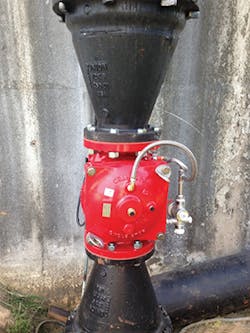While cycle stop valves are in place around the world, Cary Austin the inventor and owner of Cycle Stop Valves (CSV) headquartered in Lubbock, TX, says there are still disbelievers who can’t fathom “the simplicity of a mechanical valve that can deliver constant water pressure with equal efficiency from small flows like a single garden hose to as much flow as the pump can deliver.”
The warning saying “if it sounds too good to be true, it probably is,” comes to mind when you are promised overnight weight loss and gimmicks that make you rich. But sometimes, an invention comes along that delivers what it promises so well that it really does seem “too good to be true.”
A Counterintuitive Success Story
More than two decades ago, an enterprising young man with a pump and drilling background had a brilliant idea. He wanted to develop a means to control water pressure that was simple, reliable, and not dependent on a power source. Today, no longer a young man, Austin, says his invention works so well and is so reliable that the products “will probably still be working as good as the day they were installed after I’m long gone!”
Several cycle stop valves in use
“It’s counterintuitive to what you think will work,” explains Austin, describing how the valve can efficiently manage fluctuations in the downstream water pressure and not burn up the system’s pumps or motors.
“What happens is that the cycle stop valve opens and closes like a ball valve—it uses a spring to push it open and then a diaphragm will push it closed. The beauty of this is that the customer sets the valve at the required outgoing pressure, and that’s where it stays. So, let’s say they want all the outgoing water at 50 pounds per square inch gauge, the valve responds to the amount of water being used—if it is more or less—by opening or closing in response to downstream pressure. This simple mechanism ensures that all outgoing water is exactly at 50 pounds per square inch gauge.”
Austin says the size of the pressure tank is irrelevant. It doesn’t matter if the tank holds 1 gallon or 1 million gallons. Water goes from the pump and cycle stop valve right past the tank, directly to distribution, matching the exact flow rate being used.
Editor’s Note: In wanting to make sure this article displays adequate objectivity, both the writer and I searched for conflicting opinions but did not find any. So while Water Efficiency magazine is not endorsing the product, we’re presenting the story as it was told to us, beginning with when the writer learned of the valves from a water utility when writing about tank coatings and out of service tanks. We are open to hearing from readers who have expertise with this kind of equipment, and/or personal experiences with these valves.
Meeting Demand—One Shower, Or the Whole Town
During your stay in a large hotel you may have experienced the “morning shower phenomenon” when water pressure drops due to the demand of hundreds of people turning on the taps at the same time, something that would be a non-issue at three in the morning when most are asleep. Austin takes the illustration to a larger scale to explain how cycle stop valve maintains a constant pressure, regardless of demand, and wherever water is being used—a public utility, an irrigation system, and even a garden hose.
At 7 a.m., the demand will be different from 3 p.m. and midnight. Imagine a large pressure tank or a water tower. The pump runs at full flow until the tank is full, then the pump shuts off. Demand drains the tank as needed, then the pump is restarted and the tank is filled again. This (cycling) is repeated over and over. But the cycle stop valve, which is set to 50 psi by an adjustment bolt that sets the spring tension inside the housing, will always deliver exactly that level of outgoing water pressure, regardless of changes in demand. And, the utility will enjoy a constant 50 psi, which can also maintain a level of 115 feet in a water tower, rather than continuously dropping and then refilling. As more or fewer taps are open, the valve responds by opening and closing to deliver constant pressure.
But, explains Austin, the skeptics still argue that restricting the pump with a valve of this design can cause the pump/motor to burn out, despite the evidence from engineering research that has proven the exact opposite happens.
“The cycle stop valve has no control over motor speed because it just opens or closes in response to deliver the correct water and match the water amount being used. Many people think choking a pump back with a valve makes the amps go up and this makes the pump work harder, and that slowing the pump would make it work easier,” says Austin.
“But in fact, we’ve done years of testing and a good pump engineer will know that the very opposite is true. When you restrict the flow from a centrifugal type pump, you reduce the draw on amps, and this makes its work easier, but reducing the actual speed of the motor can be very hard on it.”
Editor’s note: This article first appeared in the September/October 2015 issue of Water Efficiency.




